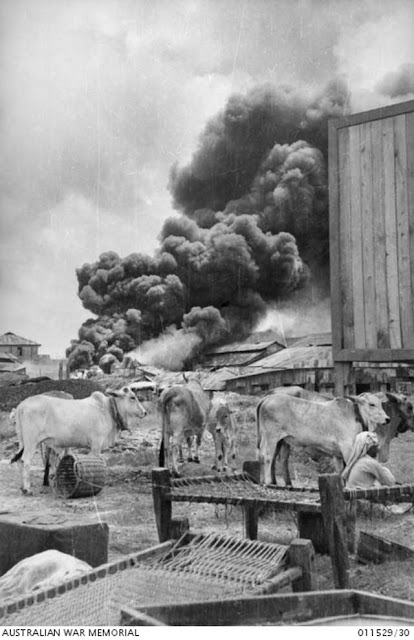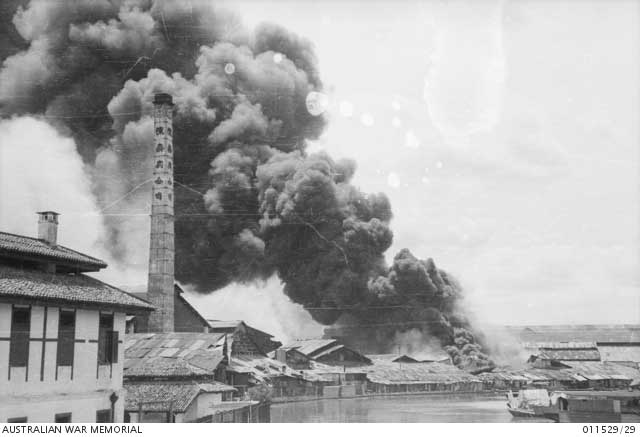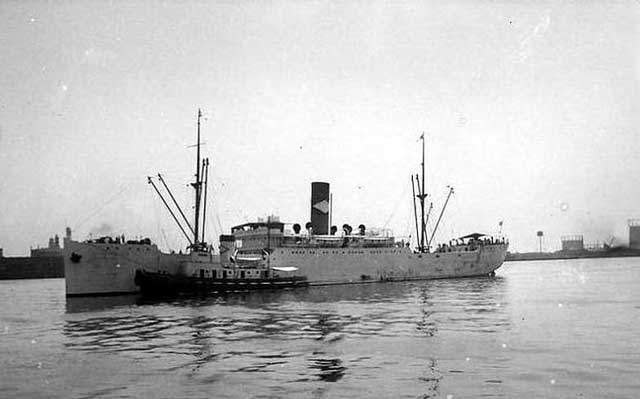Tuesday 3 February 1942
 |
| "Singapore. Two women sit on the street among rubble and debris wailing and crying, showing their grief for the small child whose dead body lies nearby in front of a damaged rickshaw after a Japanese air attack." 3 February 1942 (Bottomley, Clifford, Australian War Memorial 011529/22). |
Eastern Front: The Germans achieve a major success on
3 February 1942 when they clear the vital supply road to Fourth Army that runs from Yukhnov to Gzhatsk. German XII Corps and the 20th Panzer Division blast their way through Red Army roadblocks and "bridge the gap," thereby allowing resupply to the beleaguered army. There are Soviet forces on either side of the road - Soviet Thirty-third Army to the west and Forty-third Army to the east - and the corridor (which includes the nearby railway line) is only a few miles wide in places. However, for the first time in over a week, General Heinrici's Fourth Army can get the supplies that it needs to survive. Now, the Soviets to the west of the corridor begin to worry that they may be the ones who are trapped. However, German strength along the
Rollbahn (as the Germans call the road) is very weak, and supply convoys must have armed escorts to fight their way through at times.
In Finland, General Mannerheim sends a letter in response to a German request that Finnish forces resume an advance toward the Murmansk railway line. It says that Finnish troops would be unavailable to advance toward Belomorsk, the chosen point of attack, during the winter. The letter leaves few doubts in German minds that Mannerheim has become pessimistic about the course of the war and is unlikely to mount any offensive operations until the Red Army is basically defeated.
 |
| "A Fairey Fulmar making a low-level attack on the stern of HMS VICTORIOUS after completing a turn of fighter patrol duty." This photo was taken aboard HMS Victorious while refueling near Iceland ca. 3 February 1942. © IWM (A 7538). |
Luftwaffe ace Rolf Kaldrack (24+ victories, 3 in Spain) is killed in his Messerschmitt Bf 110 E-1 "S9+IC" (Werksnummer 4057 (factory number)) south of Toropets when his plane collides with a Mig-1 that he or his gunner (Unteroffizier Enke, also killed) had just shot down. He posthumously is awarded the 70th Oak Leaves to the Knight's Cross of the Iron Cross.
 |
| British freighter SS Pinna, bombed and destroyed by Japanese aircraft after leaving Singapore on 3 February 1942. |
Battle of the Pacific: The British Commonwealth troops have withdrawn into their island fortress of Singapore. They have troops manning the coast and have blown the only causeway to the mainland. The Japanese, however, are just across the Singapore Strait and not ready to eliminate this last Allied presence on the Malay Peninsula. Today, they bring up their heavy artillery and begin shelling the island. The British counter-fire, but they are hampered by the lack of high explosive shells. The armor-piercing shells available, which would be ideal against a naval attack, are ill-suited for land targets. While the port of Singapore remains open, using it is proving increasingly hazardous. The Japanese continue bombing Singapore and sink 10,224-ton British cargo liner Talthybius (later salvaged by the Japanese and put in service as Taruyasu Maru). Another British freighter, 4958-ton Loch Ranza, is bombed by Japanese planes and sunk while en route from Singapore to Batavia. The captain beaches the ship, but there it blows up. The Loch Ranza crew escapes and is rescued by HMAS Toowoomba. British 6121-ton tanker Pinna is hit during the same raid, also is beached, and also is lost on 3 February 1942.
 |
| "Singapore. Smoke rises from a demolished building on Rochor Canal Road (note the fallen signpost) after the air attack by the Japanese. A burnt-out vehicle lies on its side in front of the ruins of the wrecked building." 3 February 1942 (Bottomley, Clifford, Australian War Memorial 011529/31). |
An air battle begins over Port Moresby, Papua, New Guinea. The Imperial Japanese Army and Navy bombers attack while the Royal Australian Air Force (RAAF) and the United States Army Air Force (USAAF) defend. The Allies at this time are severely handicapped by lack of aircraft and other equipment, relying at the start of the battle solely on their Australian Army anti-aircraft batteries and other ground fire. Port Moresby is protected less by troops at this point than by its relative isolation, as it is extremely difficult to reach across mountain trails and any seaborne invasion must make a huge loop to the east that exposes the attacking ships to attacks from Allied naval forces and land-based bombers.
 |
| "Singapore. Neither the cattle nor their attendant seems in the least perturbed by smoke billowing from a nearby blaze, the result of a Japanese air raid." 3 February 1942 (Bottomley, Clifford, Australian War Memorial 011529/30). |
In the Netherlands East Indies, the last Allied holdouts on Ambon Island surrender. At Laha, the Japanese have captured the island's most important airfield and the defending Australians have been greatly reduced in numbers. The Australian commander at Laha, Lieutenant Commander Scott, surrenders in the morning, while a separate Allied force at Kudamati surrenders a few hours later. These surrenders lead to the Laha Massacre (see below). About 30 Australian soldiers manage to melt into the jungle and eventually find means of escaping. Among other strategic effects of the Japanese capture of Ambon, it places Japanese land-based bombers within range of Darwin, Australia (see 19 February 1942).
 |
| Singapore. Singapore firefighters quelling a blaze with their water hoses after a bombing raid by the Japanese. 3 February 1942 (Bottomley, Clifford, Australian War Memorial 011529/27). |
In the Philippines, the US Army II Corps reestablishes its line on the Pilar River after the Japanese finish evacuating their bridgehead there. The Allies continue trying to reduce the handful of Japanese pockets behind the main front, with little success. The Japanese Air Force launches an air raid on Singosari Airdrome which destroys four fully loaded USAAF B-17 bombers, adding a fifth B-17 which they shoot down nearby. Another Japanese raid at Soerabaja destroys three Royal Netherlands Navy Catalina flying boats and a USAAF B-18 Bolo bomber. The B-18 also is shot down in flight, killing all aboard (including some badly needed radar technicians). USAAF P-40s based at Blimbing Airdrome manage to intercept the Japanese planes and shoot down two fighters and a bomber at a cost of one P-40 of their own.
 |
| "Singapore. Black smoke billows into the air from a timber yard ablaze after a Japanese air attack." 3 February 1942 (Bottomley, Clifford, Australian War Memorial 011529/29). |
In Burma, the American Volunteer Group (AVG) "Flying Tigers" continue their successful air operations against attacking Japanese aircraft. Pilots of the 2nd Squadron shoot down a Japanese Army bomber over Toungoo Airdrome at about 16:00. Off Palembang, Japanese aircraft sink 5424-ton Dutch freighter Sudabar.
European Air Operations: A lull in operations due to winter weather that began on 1 February continues today.
 |
| MV Amerikaland, sunk by U-106 on 3 February 1942. |
Battle of the Atlantic: It is another good day for the German U-boats operating off of the eastern United States coast as part of Operation Paukenschlag. U-106 (Kptlt. Hermann Rasch), on its fifth patrol out of Lorient, torpedoes and sinks 15,339-ton Swedish freighter Amerikaland about 90 miles east of Virginia Beach. The Amerikaland is an independent which is hit by the first torpedo at 03:23 on 3 February 1942. Everyone manages to take to the boats, but five crewmen later die of exposure due to a snowstorm and generally frigid weather. Fifteen men survive.
 |
| "Singapore. Soldiers and civilians co-operate in rescuing wounded from damaged buildings after bombing in Japanese air attacks." 3 February 1942 (Bottomley, Clifford, Australian War Memorial 011529/18). |
U-103 (Kptlt. Werner Winter), on its sixth patrol out of Lorient, torpedoes and shells 3627-ton Panamanian banana boat San Gil about 15 miles south of Fenwick Island, Delaware, lighthouse. The ship goes down after the crew abandons it in two lifeboats which are picked up later in the day by USS Nike. There are two dead (killed when the torpedo hits the engine room) and 39 survivors. This sinking is sometimes dated on 4 February 1942, with the time of the attack variously reported as 23:50 on the 3rd and 06:43 on the 4th.
 |
| SS San Gil, sunk off the Delaware coast on 3 (or 4) February 1942. |
The battle of the small boats along the English Channel continues with great ferocity. British motor gunboats sink German freighters Hermann (a 114-ton schooner) and Schleswig-Holstein (174 tons) off the coast of Brittany. The sinking of the Schleswig-Holstein is sometimes erroneously dated to August 1942, but that apparently was another ship, perhaps of the same name.
 |
| Singapore. Smoke haze over the city after bomb attacks by Japanese. 3 February 1942 (Bottomley, Clifford, Australian War Memorial 011529/07). |
Battle of the Mediterranean: German Lieutenant General Erwin Rommel presses forward on the advance from Benghazi. The Afrika Korps captures Timimi. The British follow orders from General Ritchie and fall back toward the Gazala Line, evacuating Derna. This leaves Derna in German hands again almost exactly a year after they captured it in early 1941.
Off Tunisia, HMS Umbra (Lt. S.L.C. Maydon) torpedoes and badly damages 6142-ton Italian freighter Napoli. The captain of the Napoli acts fast and beaches the ship about 30 miles east of Sousse, Tunisia. This maneuver is successful, but aircraft destroy the beached freighter on 11 February.
 |
| A Soviet propaganda leaflet dropped on German positions in February 1942. It begins: "News from the Front. German soldiers! The German army has suffered great losses. It is doomed. You can conceal this. Read the truth about the situation at the front." It continues on to describe how the Red Army is pushing back the Germany Army around Moscow. |
War Crimes: The little-remembered battle of Ambon Island leads to one of the least-remembered massacres of the early months of the Pacific war. The Japanese spend the next fortnight murdering prisoners of war, including more than 300 Australian and Dutch soldiers near Laha Airfield. Among those executed are Commander Scott and Major Mark Newbury, both of whom led peace delegations and entered Japanese lines under flags of truce. The surviving Allied prisoners are horribly mistreated with 405 of 582 who remained in Japanese prisons perishing by 1945. This leads to a war crimes trial in 1946 which results in death sentences and imprisonment of those involved. This incident is recounted in the film "Blood Oath" (1990).
 |
| The reverse side of a Soviet propaganda pamphlet dropped on German troops in February 1942. "“IT IS EASIER TO DIE, THAN TO BEAR SUCH AGONY." |
Allied Relations: Following a difficult period in British-Chinese relations due to disputes about American lend-lease equipment, Chinese Generalissimo Chiang Kai-shek agrees to send the Chinese 6th Army into Burma. This allows the British to consolidate their own dispositions in the theater, and today they send the Indian 48th Brigade to the sector controlled by the Indian 17th Division.
 |
| "The Watch House at HMS Forte III." This is plastic armor fencing, a type of vehicle armor designed by Edward Terrell of the British Admiralty in 1940. It was cast in situ for bunkers and gun shields on the decks of ships. The plastic was good at deflecting bullets. A patent court later awarded Terrell sole credit for this invention, which saved many lives after being fitted to about 10,000 ships. 3 February 1942 (© IWM (A 9985)). |
US Military: The Far East Air Force shifts thirteen P-40s of the 20th Pursuit Squadron from Darwin, Australia, to Java.
Canadian Military: The Canadian Women's Auxiliary Air Force becomes the Royal Canadian Air Force (Women's Division).
British Military: The British activate Port T, a top-secret naval base on Addu Atoll. This is a remote island southwest of the tip of India.
 |
| German Berlin police leaders General of Police Kurt Daluge, right, and SS-Gruppenführer Dr. Ernst Grawitz meet at the Kurmark Police Station, 3 February 1942. |
British Homefront: The government sets maximum prices for certain types of clothing. For instance, the maximum price for a suit is set at £4 18s 8d.
American Homefront: Major League Baseball owners meet and decide to allow fourteen night games for each club (the Washington Senators get 21) this season. They also schedule two All-Star games, one with a military all-star team. They set a curfew for all night games, with no inning to start after 00:50.
 |
| Singapore. Some of the city buildings with smoke rising from fires caused by bombing in Japanese air attacks, only days before the Japanese landed on the island. 3 February 1942 (Bottomley, Clifford, Australian War Memorial 011529/01). |
February 1942
February 1, 1942: The US Navy Strikes Back
February 2, 1942: Germans Recovering in Russia
February 3, 1942: Japanese Shell and Bomb Singapore
February 4, 1942: Battle of Makassar Strait
February 5, 1942: Empress of Asia Sunk
February 6, 1942: The Christmas Island Body
February 7, 1942: The Double-V Campaign
February 8, 1942: Japan Invades Singapore
February 9, 1942: French Liner Normandie Capsizes
February 10, 1942: US Car Production Ends
February 11, 1942: Tomforce Fails on Singapore
February 12, 1942: The Channel Dash
February 13, 1942: Japanese Paratroopers In Action
February 14, 1942: RAF Orders Terror Raids
February 15, 1942: Japan Takes Singapore
February 17, 1942: Indian Troops Defect to Japanese
February 18, 1942: Battle of Badung Strait
February 19, 1942: FDR Authorizes Internment Camps
February 20, 1942: O'Hare the Hero
February 21, 1942: Crisis in Burma
February 22, 1942: Bomber Harris Takes Over
February 23, 1942: Bombardment of Ellwood, California
February 24, 1942: US Raid on Wake Island
February 25, 1942: Battle of Los Angeles
February 26, 1942: Gneisenau Eliminated
February 27, 1942: Battle of Java Sea
February 28, 1942: Battle of Sunda Strait
2020
















No comments:
Post a Comment